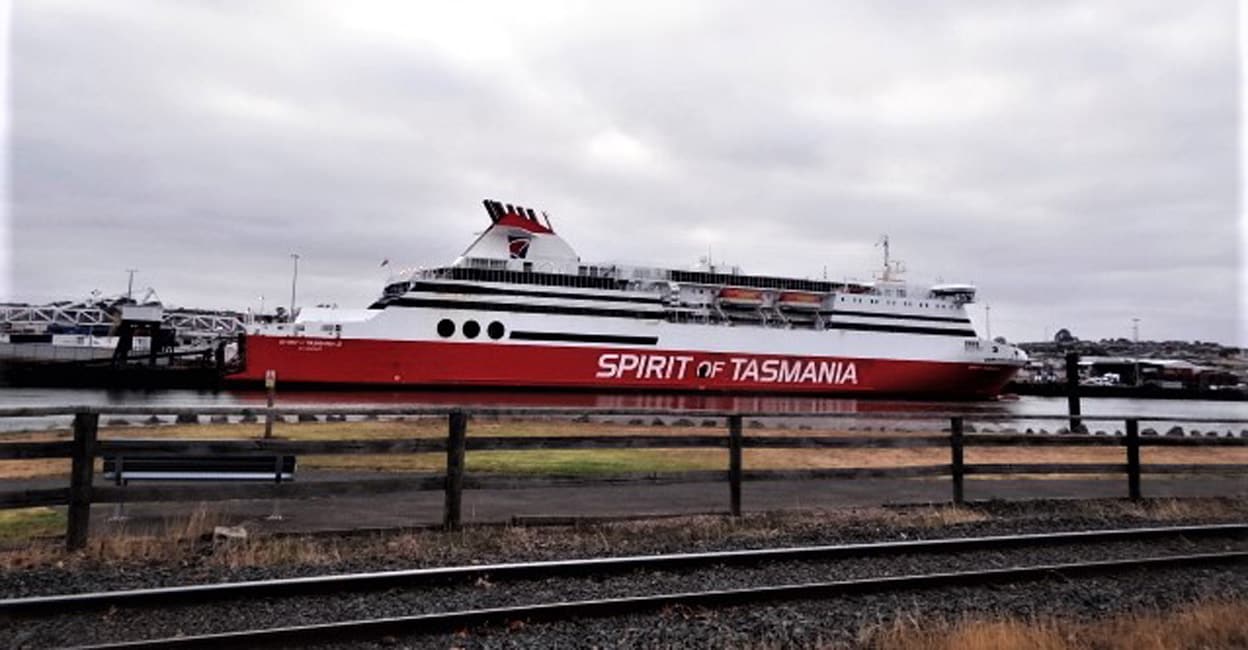A Tasmanian crossing: We were in the midst of poppy fields

The Lonely Planet says that most travellers to Australia ignore Tasmania, a beautiful world with a unique history.
The Lonely Planet says that most travellers to Australia ignore Tasmania, a beautiful world with a unique history.
The Lonely Planet says that most travellers to Australia ignore Tasmania, a beautiful world with a unique history.
'Spirit of Tasmania,' the 11-decked, overnight ferry to Tasmania towers over Melbourne Port’s Station Pier, light smoke curling out of its chimneys. It’s 5 pm and people and vehicles are already queued up to board. We take our place in the car queue. I’m with my Sydney friend Santhosh Joseph and family. Santhosh’s friend Reji and family are in another car. All vehicles undergo a customs check for banned items, mainly plants, fruits, seeds and food stuff that can harm or disrupt the island’s special eco-system. Almost everyone, including us, loses something or the other to the customs, mostly food items. The long queues disappear in no time, cars roll into ship’s hold which is the size of a football court and people move up the winding staircases or lifts into the cabin areas.
You get your cabin-key as you leave the parking lot. That’s it. Then you’re on your own. You just follow directions, climb up and down stairs, walk through a maze of long, narrow, corridors and find your cabin. Inside it’s compact, comfortable, clean and of course a bit claustrophobic. You open the porthole curtain and are somewhat surprised to see the sea heaving outside. The realization one is on water is startling because as a traveler one’s so used to seeing the land or the sky outside the window. It’s also exciting, even a little frightening, because the sea is such a mighty force. Then you walk out and discover the lounges, restaurants, bars, game- parlors and the decks. They’re all crowded. There are also people already slumped on sofas watching TV.

At 7.30 pm the ship lets out a long whistle, vibrates under the engines’ thrust and amazingly slowly for such a giant, starts moving. I stand on the deck and watch the Australian shore receding. I can feel the soft purring of the monster engines hidden away somewhere in the bowels of the ship.
The ‘Lonely Planet’ says that most travelers to Australia ignore Tasmania, a beautiful world with a history of its own. If Australia is Down Under, Tasmania is around 500 kms still Down Under in the Antarctic Ocean, also called the Southern Ocean. Beyond that there’s nothing but the cold waters of the Antarctic till you reach the South Pole 2,500 kms away – except the little, lush green, unpopulated Macquarie Island, a UNESCO World Heritage Site under Tasmanian administration. As a traveler I’m thrilled. I’m on a trip different in many ways from any I’ve undertaken.
Now we’re in the outer sea and the ocean begins to swell and surge under us and the big waves go to work. The ship increases speed and we can hear and feel the waves hitting us hard. The ship is now like a tipsy dancer, swaying every way and suddenly rising and dipping. Now I see the use of vomit bags stacked everywhere in easy reach. Lots of people are gagging or throwing up. They sit bent down after the first gag, ready for the next, or lie curled up on the sofas. They’re looking sad because the journey is ruined for them. Throwing up is exhausting. And you can’t have fun eating and drinking or watching the sea from the deck. But the ship is unrelenting in its battle with the Ocean. It shows no mercy.
Nature, for some reason, has rendered me immune to motion sickness. Therefore, I stand on the forward deck and watch the ship’s bow cleaving a huge, arrow-like path of white water through the boiling, black sea. I see a few dolphins flash by, somersaulting among the waves and in the distance a whale reaching for the sky and falling back with a splash. Only the sea gulls keep the ship constant company, screeching, flying around and occasionally resting on the rails. I wake up a couple of times in the night and feel the unyielding strength of the machines pulsate through fabric of the ship. It was as if the ship was a living creature flexing its muscles. Next morning we wake up to the ship moving softly and silently close to Tasmania’s shore and soon we’re docked at the Esplanade terminal in Devonport on the southern coast of the island. Our car rolls down the ramp and we’re on the road, all the way to Hobart, the capital.
Let’s put the extremely sad past of Tasmania behind us before proceeding further. The saddest and most tragic story is that of the aborigines. A people with a 40,000-year-old past, there were around 15000 of them in Tasmania when the British arrived in 1803. They were so brutally exterminated by British settlers that only 47 of them were alive in 1847. The last Tasmanian died in 1905 and with that a whole human lineage vanished from the face of the earth. Over a dozen languages they spoke vanished with them.
Equally inhuman, but in a different socio-cultural context, was the fate of the British convicts who were condemned to the penal settlements of Tasmania – then called Van Diemen’s Land. (The first settlements were in mainland Australia.) Between 1830 and 1877, 12,500 convicts, female and male, young and old, served their time in Port Arthur settlement, which was one among four. To quote ‘Our Tasmania,’ a history site, ‘It’s reputation for cruelty and barbarism spread throughout the Empire.’ About 80,000 convicts had been landed in Tasmania before the practice of penal settlements was brought to an end in 1877.
The suffering of these women and men differed from that of the aborigines only in the sense that here violence was unleashed by Christians against Christians and whites against whites. And many survived the horror because the aim of the authorities was not their annihilation as in the case of the aborigines. I walked among the ruins of the penal settlement at Port Arthur. It’s like a beautiful park today, but you cannot walk there without feeling disgust and anger at the power systems that made men heartless and bloodthirsty – and continue to do so today.
Tasmania is famous for its mountain, lake and coastal scenery and unique flora and fauna which is the result of millenniums of geographic and genetic isolation from the rest of the world. Thus, for example, we have the celebrated platypus which has a duck’s bill, webbed feet, an otter’s body and a beaver’s tail. It is a mammal that lays eggs instead of giving birth and suckles its babies. The most common resident animal of Tasmania is the wallaby – a junior version of the kangaroo. They’ve a hard life indeed. The highways are strewn with their splattered bodies – poor things are simply unprepared for the highspeed traffic.
One of my great moments in Tasmania was the trek along the Cradle Valley Boardwalk which circles a part of Lake St. Clair at the foot of the Cradle Mountains. It takes about 3 hours to complete the walk. It’s an amazing experience of wilderness, water, sky and forest, and silence and aloneness. It also gets eerie. Sometimes you feel the walk is not going to end and that you’re lost. But it can’t be because the lake is right there on one side of you, the blue water reflecting the sky and the encircling forest. Then suddenly you panic remembering there’s a deadline because you need to get back to the bus-park before the last bus leaves for the visitors’ center. Can I make it? But then the lake, the Cradle Mountains and the wide, blue sky take over, the silence leads you and slowly and slowly you are back at the bus-park, feeling jubilant and proud – and happily tired. The bus is only getting filled.
It may surprise many to know that Tasmania is the poppy production hub of the world. One day as we were driving through the interior, we found ourselves surrounded by endless fields of yellow flowers fenced off by barbed wire and notices that said: ‘Danger. Prohibited Area. KEEP OUT. Trespassers Prosecuted. Illegal use of crop may cause DEATH.’ We were in the midst of poppy fields!
Tasmanian farmers produce about 50% of the world’s legitimate poppy straw that is refined into opiates like morphine and codeine used by the pharmaceutical industry. As an ex-farmer I was fascinated. I looked for more information and found out that if I have the capital, I can become a poppy farmer in Tasmania. The basic requirement is a valid contract with a licensed processing company to grow the crop and a poppy grower’s license from the Poppy Advisory and Control Board. Tasmanian Alkaloids is the licensed processor of poppy in Tasmania. Well, I’m still weighing the pros and cons. I’m sure the capital will drop upon me from heaven one day.
I must admit I was startled to find the following inscription at the bottom of the site of the Department of Natural Resources and Environment of Tasmania where I got my information: ‘In recognition of the deep history and culture of this island, we would like to acknowledge and pay our respects to all Tasmanian Aboriginal people; the past and present custodians of the Land.’
May be we shouldn’t lose hope in humanity yet.
Paul Zacharia is a well-known Indian writer and columnist.


